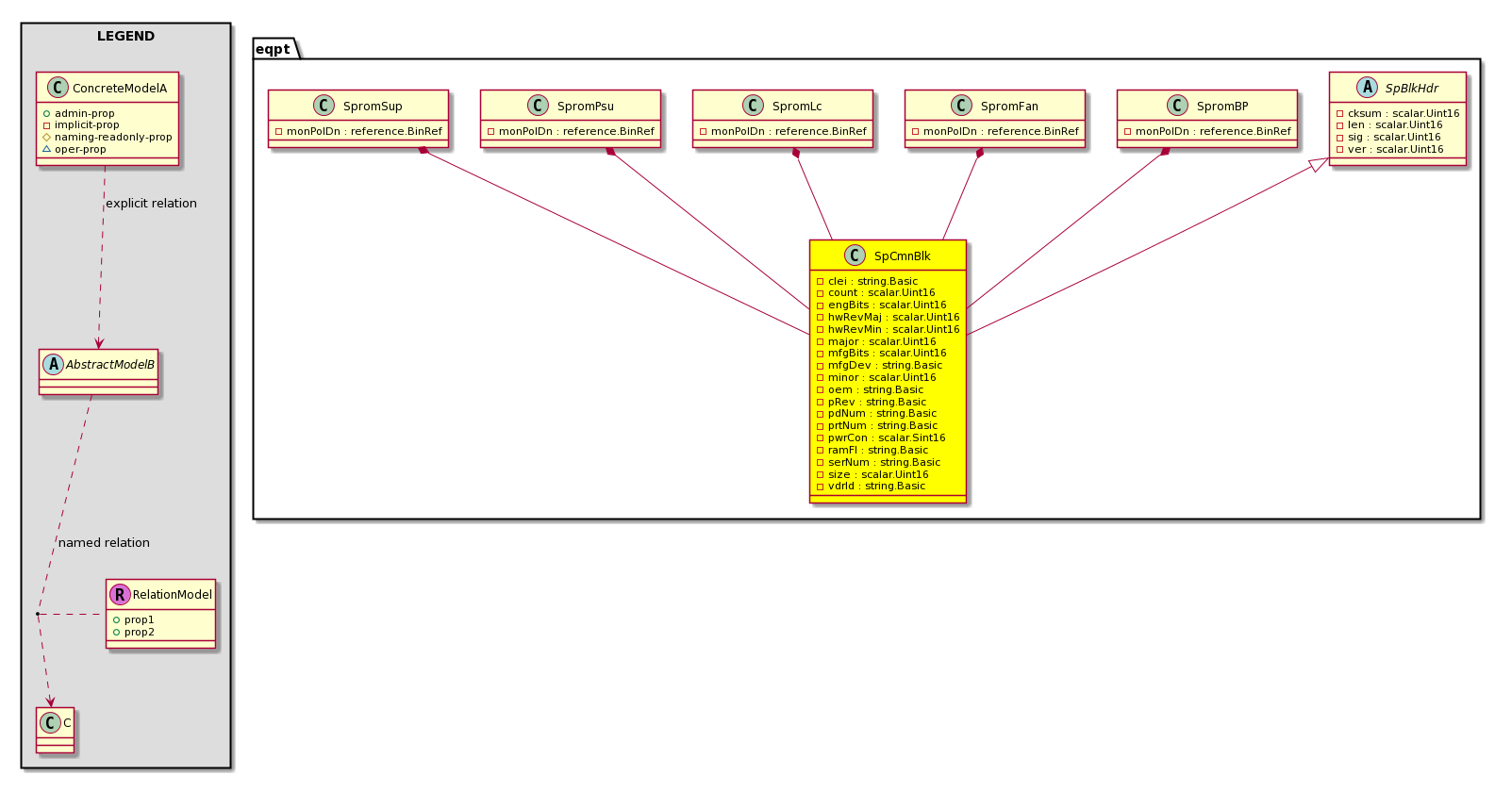| Properties Summary |
childAction
Type: mo:ModificationChildAction
Primitive Type: scalar:Bitmask32
Units: null
Encrypted: false
Access: implicit
Category: TopLevelChildAction
Comments:
-
Delete or ignore. For internal use only.
| |
| Constants |
| deleteAll |
16384u |
deleteAll |
NO COMMENTS
|
| ignore |
4096u |
ignore |
NO COMMENTS
|
| deleteNonPresent |
8192u |
deleteNonPresent |
NO COMMENTS
|
| DEFAULT |
0 |
--- |
This type is used to
|
|
cksum
Type: scalar:Uint16
Units: null
Encrypted: false
Access: implicit
Category: TopLevelRegular
Comments:
-
block checksum
clei
Type: string:Basic
Units: null
Encrypted: false
Access: implicit
Category: TopLevelRegular
Comments:
-
The common language (CLEI) code of the SPROM common block. The SPROM on the device contains detailed information about the hardware, including serial, part, and revision numbers.
count
Type: scalar:Uint16
Units: null
Encrypted: false
Access: implicit
Category: TopLevelRegular
Comments:
-
block count
dn
Type: reference:BinRef
Units: null
Encrypted: false
Access: implicit
Category: TopLevelDn
Comments:
-
A tag or metadata is a non-hierarchical keyword or term assigned to the fabric module.
engBits
Type: scalar:Uint16
Units: null
Encrypted: false
Access: implicit
Category: TopLevelRegular
Comments:
-
engineering bits
hwRevMaj
Type: scalar:Uint16
Units: null
Encrypted: false
Access: implicit
Category: TopLevelRegular
Comments:
-
hardware revision major number
hwRevMin
Type: scalar:Uint16
Units: null
Encrypted: false
Access: implicit
Category: TopLevelRegular
Comments:
-
hardware revision minor number
len
Type: scalar:Uint16
Units: null
Encrypted: false
Access: implicit
Category: TopLevelRegular
Comments:
-
block Length
major
Type: scalar:Uint16
Units: null
Encrypted: false
Access: implicit
Category: TopLevelRegular
Comments:
-
Fru Major
mfgBits
Type: scalar:Uint16
Units: null
Encrypted: false
Access: implicit
Category: TopLevelRegular
Comments:
-
The manufacturing bits.
mfgDev
Type: string:Basic
Units: null
Encrypted: false
Access: implicit
Category: TopLevelRegular
Comments:
-
manufacturing Deviation
minor
Type: scalar:Uint16
Units: null
Encrypted: false
Access: implicit
Category: TopLevelRegular
Comments:
-
Fru Minor
modTs
Type: mo:TStamp
Primitive Type: scalar:Date
Units: null
Encrypted: false
Access: implicit
Category: TopLevelRegular
Comments:
-
The time when this object was last modified.
| |
| Constants |
| never |
0ull |
never |
NO COMMENTS
|
| DEFAULT |
never(0ull) |
never |
NO COMMENTS
|
|
oem
Type: string:Basic
Units: null
Encrypted: false
Access: implicit
Category: TopLevelRegular
Comments:
-
oem string
pRev
Type: string:Basic
Units: null
Encrypted: false
Access: implicit
Category: TopLevelRegular
Comments:
-
part Revision
pdNum
Type: string:Basic
Units: null
Encrypted: false
Access: implicit
Category: TopLevelRegular
Comments:
-
product number
prtNum
Type: string:Basic
Units: null
Encrypted: false
Access: implicit
Category: TopLevelRegular
Comments:
-
part number
pwrCon
Type: scalar:Sint16
Units: cA
Encrypted: false
Access: implicit
Category: TopLevelRegular
Comments:
-
The SPROM contents for a power supply module number. The SPROM on the device contains detailed information about the hardware, including serial, part, and revision numbers.
ramFl
Type: string:Basic
Units: null
Encrypted: false
Access: implicit
Category: TopLevelRegular
Comments:
-
RAM failure code
rn
Type: reference:BinRN
Units: null
Encrypted: false
Access: implicit
Category: TopLevelRn
Comments:
-
Identifies an object from its siblings within the context of its parent object. The distinguished name contains a sequence of relative names.
serNum
Type: string:Basic
Units: null
Encrypted: false
Access: implicit
Category: TopLevelRegular
Comments:
-
serial number
sig
Type: scalar:Uint16
Units: null
Encrypted: false
Access: implicit
Category: TopLevelRegular
Comments:
-
block signature
size
Type: scalar:Uint16
Units: null
Encrypted: false
Access: implicit
Category: TopLevelRegular
Comments:
-
sprom size
status
Type: mo:ModificationStatus
Primitive Type: scalar:Bitmask32
Units: null
Encrypted: false
Access: implicit
Category: TopLevelStatus
Comments:
-
The upgrade status. This property is for internal use only.
| |
| Constants |
| created |
2u |
created |
In a setter method: specifies that an object should be created.
An error is returned if the object already exists.
In the return value of a setter method: indicates that an object has been created.
|
| modified |
4u |
modified |
In a setter method: specifies that an object should be modified
In the return value of a setter method: indicates that an object has been modified.
|
| deleted |
8u |
deleted |
In a setter method: specifies that an object should be deleted.
In the return value of a setter method: indicates that an object has been deleted.
|
| DEFAULT |
0 |
--- |
This type controls the life cycle of objects passed in the XML API.
When used in a setter method (such as configConfMo), the ModificationStatus
specifies whether an object should be created, modified, deleted or removed.
In the return value of a setter method, the ModificationStatus indicates the actual
operation that was performed. For example, the ModificationStatus is set to "created"
if the object was created. The ModificationStatus is not set if the object was neither
created, modified, deleted or removed.
When invoking a setter method, the ModificationStatus is optional:
If a setter method such as configConfMo is invoked and the ModificationStatus
is not set, the system automatically determines if the object should be created or modified.
|
|
vdrId
Type: string:Basic
Units: null
Encrypted: false
Access: implicit
Category: TopLevelRegular
Comments:
-
The vendor ID of the SPROM common block. The SPROM on the device contains detailed information about the hardware, including serial, part, and revision numbers.
ver
Type: scalar:Uint16
Units: null
Encrypted: false
Access: implicit
Category: TopLevelRegular
Comments:
-
block version

